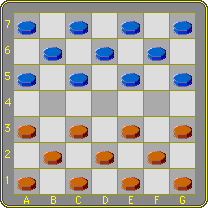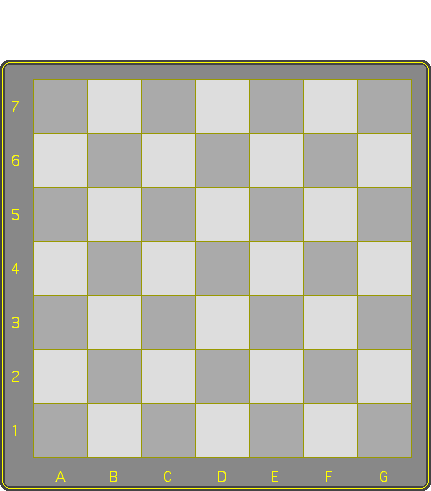Page 4 of 7
Lasca | Lasca is a column checkers game designed by the then Chess World Champion Emanuel Lasker. The patent was filed in 1911. Lasker held English Draughts in high esteem, After being introduced to Bashni in Russia, he designed Lasca to be column checkers with English Draughts as a substrate - Column Draughts, so to speak. The other important feature of Lasca is that it is played on a 7x7-board, as shown on the left. |
The general remarks given in the chapters about column checkers and Bashni appply to Lasca, too. However, there is much less space in the opening, which affects the game in a negative way. The following game gives an illustration:
| no Sound - Flip board | ||
|
to move
|
|
|
|
|
||
Note the overwhelming numbers of forced moves for Black. The crammed board may allow the side with initiative to set up long combinations. The small board, the high proportion of forcing moves, and the low branching factor in general would make tournament Lasca dependent on opening books. If the game goes beyond the opening, the remaining stacks may be too vulnerable to do anything constructive with them. Any combination might give the opponent a piece strong enough to dwarf any advantage gained from it. Draws are the most likely results of such games.
Other positions may emerge in which a defining feature of Lasca will show, namely that stacks without a king on top, cannot capture backwards. So a piece the top man of which is captured, cannot capture back unless the second man of its cap is also a king, liberated by that very capture. In other words, the makeup of a stack becomes a decisive factor. In these positions, usually one manoeuvres a lot to achieve promotion and to get kings on the tops of one’s own stacks. If such a king is captured, further maneuvring to the same effect may ensue. These kinds of Lasca games can be quite drawn out. Ten or more promotions during a game are not an exception.
Lasca is not exactly a bad game. The small board strongly shapes the game and moves its gameplay closer to that of Fanorona. Bashni is the strategically and tactically richer game. However, Lasca introduced column checkers to a larger Western audience.
Games from the checkers family usually feature a small branching factor (ten or less mostly). Given their tactical nature and the many forced moves, opening books, as far as they exist, play an important role. With a broad player base, they may eventually become more important than individual skill. In Lasca, with its narrow opening alleys, they already are.






